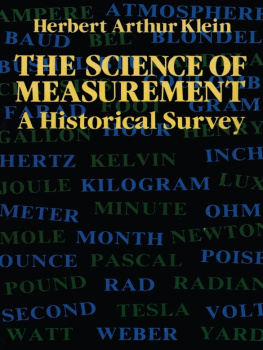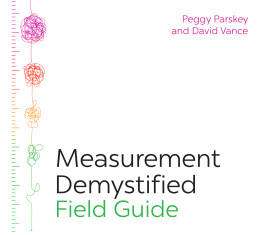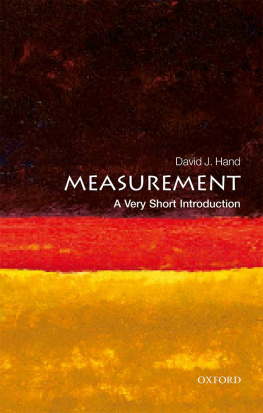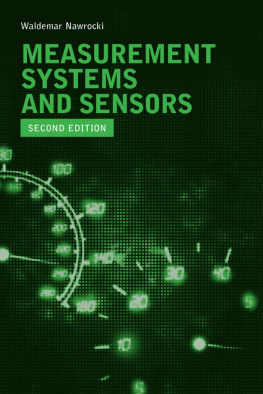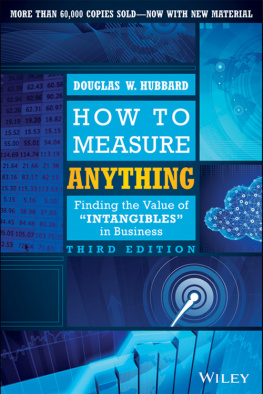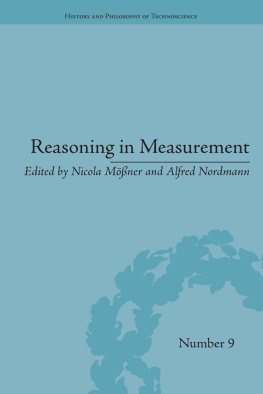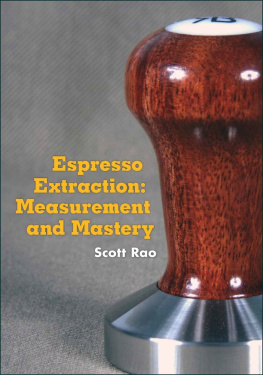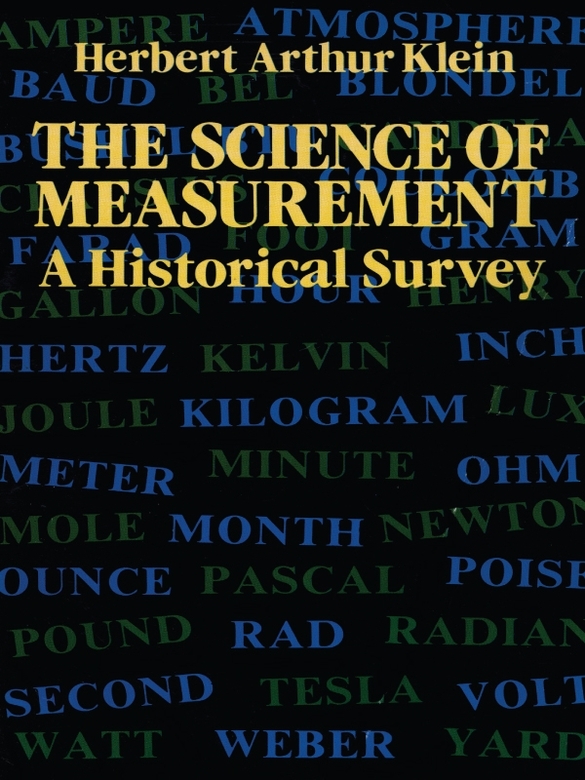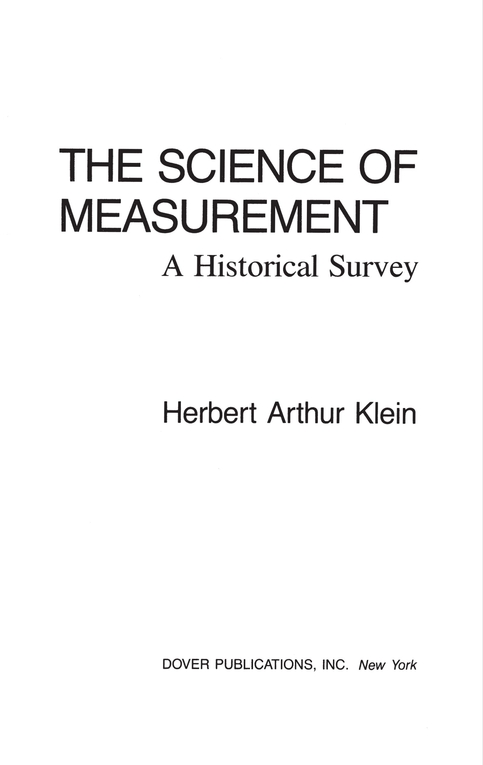Copyright 1974 by H. Arthur Klein.
All rights reserved.
This Dover edition, first published in 1988, is an unabridged, corrected republication of the work originally published by Simon & Schuster, Inc., New York, in 1974, and by George Allen & Unwin Ltd., London, in 1975 under the title The World of Measurements: Masterpieces, Mysteries and Muddles of Metrology.
Klein, H. Arthur.
The science of measurement : a historical survey / Herbert Arthur Klein.
p. cm.
Reprint. Originally published: The world of measurements. New York : Simon & Schuster, 1974.
Includes index.
1. Weights and measures. 2. Weights and measuresHistory. I. Title.
Introduction
Expression of hail and farewell is the welcome prerogative of an author at the penultimate point, when the text is crystallized, for better or worse, and before the start of the production processes that are to transform the word into substance.
This recalls the insight of Blaise Pascal, one of the great men of measurement, to whom the following pages seek to do justice; for he noted that The last thing we learn when writing a book is what to put first.
First place appears, beyond doubt, to belong to two outcomes of the long labors that produced the following fifty-four chapters: one a small confession, the other a multiple statement of sincere thanks.
The confession can be conveyed in a phrase from another Introduction, written nearly a score of years ago by James R. Newman for his esteemed four-volume anthology, The World of Mathematics: what was envisaged as a volume of moderate size has assumed dimensions which even a self-indulgent author must acknowledge to be extended. First thanks are accordingly offered to Peter Schwed of Simon and Schuster for permitting the self-indulgence. And to the readers of every age, kind and condition, the author confesses that he found the subject matter so infernally fascinating that briefer treatment seemed undesirable, even when attainable.
Though the present work can be called extended, the author feels the effects of the fisherman syndrome. This is the recollection expressed by Yes, but you should have seen the ones that got away! Or better, by the ones that were tossed back and not brought home. With a mixture of resignation and regret the author recalls a variety of aspects of modern metrology that remain unmentioned, some because of considerations of length, others because of their peculiar characteristics.
In particular, there is here no exploration of the realm of biochemical and pharmaceutical metrology, with its units of potency or efficacy, so basic in endocrinology, enzyme studies and other active areas. To deal properly with all this, a separate work obviously is required.
The efforts, spread over nearly ten years, which culminate in the present book were aided by many acts of assistance and encouragement from a number of patient, generous and informed persons. Some of that help came in correspondence, some in conversations. Much of it was in response to inquiries initiated by the author, and brought either correction or validation of conclusions that were as yet but tentative. And an appreciable as well as appreciated part of the help amounted mainly to a bolstering of the authors belief that a work as wide-ranging as this one could prove useful to laymen and specialists alike.
Quite possibly some of those named in the following thank-you list may by this time not recall the occasion or nature of the help for which they are thanked; but the author assuredly has not forgotten. There is no rational way to assign a rank-order of thanks here, so the accidental sequence of the alphabet is followed. Doctoral and professorial titles are omitted, but individuals are identified by positions held at the time their help was given:
James A. Barnes, Chief, Time and Frequency Division, Institute for Basic Standards, National Bureau of Standards; J. E. Barrell, Director, Customs Cooperation Council, Brussels, Belgium; Bruce B. Barrow, Technical Activities Board, Institute of Electrical and Electronics Engineers; J. de Boer, Instituut voor Theoretische Fysica, Universiteit van Amsterdam, Holland; Stephen Dresner, London, author of the valuable Units of Measurement: An Encyclopedic Dictionary (Aylesbury, England, 1971).
Also: Stanley Feuer, Feuer Corporation, air conditioning contractors, Los Angeles; L. E. Howlett, Division of Applied Physics, National Research Council of Canada, Ottawa; H. S. Hvistendahl, Newcastle upon Tyne, author of Engineering Units and Physical Quantities (London, 1964); Daniel Kleppner, Department of Physics, Massachusetts Institute of Technology; Joel L. Lebowitz, Physics Department, Yeshiva University, Belfer Graduate School of Science, New York City.
Also: A. G. McNish, Chief, Metrology Division, Institute for Basic Standards, National Bureau of Standards; H. Moreau, Bureau International des Poids et Mesures, Svres, France; Sheldon Novick, Editor, Environment, St. Louis, Mo.; Ronald F. Peierls, Acting Leader, High Energy Theory Group, Brookhaven National Laboratory, L. I., N.Y.; H. Preston-Thomas, Division of Physics, National Research Council of Canada, Ottawa; Theodore T. Puck, Director, Institute for Cancer Research, and Professor of Biophysics and Genetics, University of Colorado Medical Center, Denver.
Also: Arthur Schawlow, Department of Physics, Stanford University; Arnold H. Silver, Physics Department, Scientific Laboratory, Ford Motor Company, Dearborn, Mich.; Louis F. Sokol, President, Metric Association, Inc.; Martin V. Sussman, Department of Chemical Engineering, Tufts University, Medford, Mass.; M. P. Thekaekara, NASA Goddard Space Flight Center, Greenbelt, Md.; Alvin Wald, University Medical Center, University Hospital, New York City; George P. Yost, Department of Physics, University of California at Berkeley.
A special category of thanks also goes to several individuals for courtesies and attentions that once again justify a truism that the present author put into doggerel in the Foreword to a quite different book, about a dozen years ago:
Could books like these be finished, sans
The work of fine librarians?
By words alone cant be repaid
Helpful librarians great aid!
Such thanks are due the units of the great library complex of the University of California at Los Angeles, as represented by Wally Pegram, Physics Library; John Hill, Geology Library; Rosalie Wright, Engineering and Mathematical Sciences Library; and also through University Librarian Page Ackerman, to each and every staff member who made the authors efforts more pleasant and productive.
Similar thanks are offered to Evelyne Hamilton, Librarian, Malibu Branch of the Los Angeles County Library, and her staff.
In an era when libraries great and small suffer under shortsighted budgetary cuts and enforced reductions of services, the continuing helpfulness of all these staffs merits more than perfunctory mention.
In the private sector, thanks are given for access to the reference facilities of the Hughes Research Laboratory of Malibu, through the good offices of Toby Ann Mandel, Librarian, and Ed Reese, Technical Information Manager. Good neighbors indeed!

